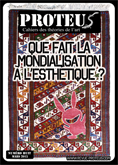Sex tape et road movie
Abstract
 Télécharger l’article
Télécharger l’article
Paru dans : Proteus n°8

Entre 1964 et 1966 Carolee Schneemann et James Teeney tournent Fuses, en 1992 Sophie Calle et Greg Shephard réalisent No sex last night ; ces deux films seront analysés de manière à en dégager les ambitions féministes. Durant les 27 ans qui les séparent, la place des femmes dans la pratique artistique a évolué, autant que leur tactique de subversion des lois du genre. La sexualité, terrain d’expérimentation choisi par les deux artistes, met en lumière les relations homme-femme, mais si Carolee Schneemann en donne une image positive dans un champ exclusivement intime, Sophie Calle joue avec les stéréotypes sociaux liés au genre. Si dans le premier film, tourné dans les années 1960, l’artiste revendique le droit de mettre en ouvre son désir, tant sexuel, qu’esthétique, pour pouvoir se constituer en tant que sujet, dans le second, tourné dans les années 1990, l’artiste, argument quasi exclusif de l’ouvre, avance masquée, elle multiplie ses identités et subvertit systématiquement la construction des genres.
Mots-clés : artiste féministe — genre/gender — hétérosexualité — subversion
Between 1964 and 1966 Carolee Schneemann and James Teeney shoot Fuses then in 1992 Sophie Calle and Greg Shephard directed Double blind; these two movies will be analyzed in order to highlight their feminist ambitions. During the 27 years that separate them, the place of the women in the artistic practice has evolved, as much as their ways of subverting gender laws. Sexuality, a field of experimentation chosen by both artists, highlights the relationships between men and women, but if Carolee Schneemann gives a positive image concentrated in the intimate field, Sophie Calle plays with the gender social stereotypes. As in the first movie, shot in the 60s, the artist claims the right to implement her desire, sexual as well as aesthetics to be able to establish herself as subject, in the second film shot in the 90s, the almost exclusive argument of the work is that the artist moves forward hiding herself, multiplying identities and subverting systematically gender constructions.
Keywords : feminist artist — genre/gender — heterosexuality — subversion








